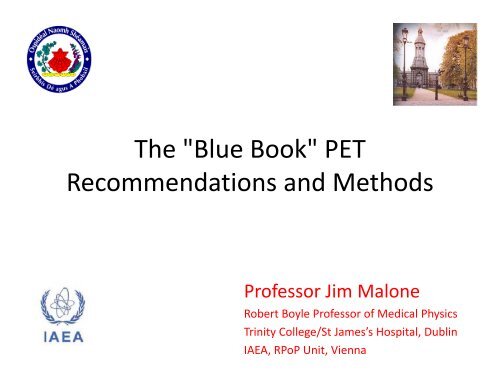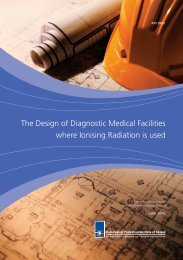Blue Book - Radiation Shielding for Medical Instalations
Blue Book - Radiation Shielding for Medical Instalations
Blue Book - Radiation Shielding for Medical Instalations
You also want an ePaper? Increase the reach of your titles
YUMPU automatically turns print PDFs into web optimized ePapers that Google loves.
The "<strong>Blue</strong> <strong>Book</strong>" PET<br />
Recommendations and Methods<br />
Professor Jim Malone<br />
Robert Boyle Professor of <strong>Medical</strong> Physics<br />
Trinity College/St James’s Hospital, Dublin<br />
IAEA, RPoP Unit, Vienna
What is Different<br />
• Photon Energy (511<br />
keV)<br />
• Relatively High Activity<br />
• Relatively Short Half Life<br />
( 18 F, 109.8 min, many shorter)<br />
• Production, distribution<br />
and labelling<br />
• Metabolism of the<br />
radiopharmaceuticals<br />
• Patient flow and<br />
management<br />
Imaging equipment<br />
Based on AAPM 108 AND Simkin et al.
Areas Required<br />
• Patient Interview area<br />
• Patient waiting area<br />
• Uptake/injection areas<br />
• Patient WC<br />
• PET scanner room<br />
• Control room/area<br />
• Dispensing area<br />
• Waste storage area<br />
• Patient Interview area<br />
• Very important to<br />
reducing staff dose and<br />
amount of shielding<br />
• Patient fully briefed on<br />
what will happen and<br />
questions answered<br />
fully be<strong>for</strong>e bf injection
Some Principles and Siting<br />
Relationships<br />
• Close affinity with Nuclear Medicine<br />
• If no restrictions on access, constraint is 0.3<br />
• Protect staff and public<br />
• Protect scanner from patient interference<br />
• Patients enter and leave without entering<br />
“staff only” areas<br />
• Protect scanners/counting equipment in<br />
neighbouring departments from patient<br />
entering or leaving
A Layout <strong>for</strong> a PET Facility<br />
Grouping patient areas reduces amount of shielding needed and staff dose
The Scanning<br />
Area
The Scanning Area (Photo)<br />
• Typically 30 – 50 m 2 , size<br />
matters<br />
• With newer systems, need<br />
<strong>for</strong> server area may not<br />
arise<br />
• Console are accessible to<br />
general hospital staff<br />
“attracts” constraint 03 0.3,<br />
i.e. design challenge<br />
• PET/CT shielding and<br />
injector issues
Uptake Areas
Uptake Areas (Photo)<br />
• Number required<br />
depends the workload<br />
• Usually 3 to 6<br />
• <strong>Shielding</strong> required<br />
• CCTV will reduce staff<br />
dose<br />
• Use of concrete nibs<br />
• Dedicated toilet<br />
reduces patient traffic<br />
and need <strong>for</strong> shielding<br />
elsewhere
Dispensing and Waste<br />
• Similar to Nuclear Medicine<br />
• Higher energy, will mean heavier shielding<br />
• Delivery arrangements likely to be more<br />
frequent<br />
• Less radiopharmaceutical handling<br />
• Waste management will require segregated<br />
storage and different levels of shielding. Well<br />
managed, apart from short term, it can be<br />
shared with nuclear medicine
PET Radiopharmacy
<strong>Shielding</strong> Calculations<br />
• Data <strong>for</strong> 18 F:<br />
– Activity given: 555 MBq<br />
– Dose Rate Const: 0.148µSvm 2 /MBqh <strong>for</strong> point<br />
– Becomes: 0.092µSvm 2 /MBqh <strong>for</strong> patient<br />
– Assume 1h uptake tk period<br />
– Assume 50 patients/week, 52 week year, and 4 m<br />
to point of interest in area of 10occupancy 1.0 occupancy, with<br />
non radiation workers.<br />
• Dose Constraint: 03mSv 0.3
<strong>Shielding</strong><br />
Calculation<br />
(PET Scanning<br />
Room)
<strong>Shielding</strong><br />
Calculation<br />
(PET Uptake Room)
<strong>Shielding</strong> Data<br />
(from AAPM, 2006)<br />
mm Pb; or<br />
cm Concrete<br />
Transmission<br />
1.0 0.89 0.96<br />
5.0 0.52 0.72<br />
10 0.25 0.40<br />
50 0.0005 0.0009
Conclusions<br />
• High Energy and High Activity<br />
• Balance size, distance and shielding<br />
• Separate staff and patients as far as is<br />
consistent with good care<br />
• <strong>Shielding</strong> calcualtions are individual <strong>for</strong> now,<br />
and more documented experience needed
















